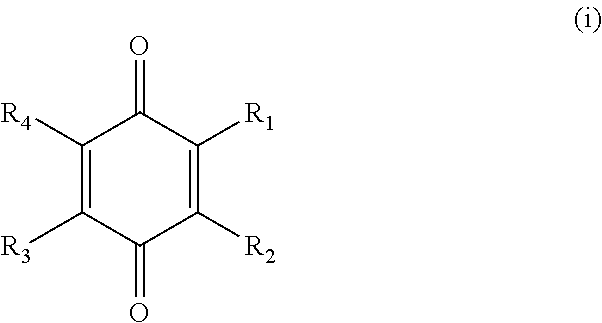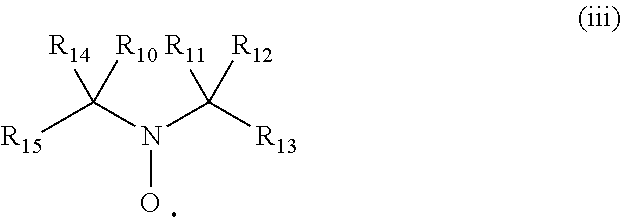During the industrial production of vinyl aromatic monomers or other ethylenically unsaturated monomers there is usually a requirement for high temperature processing operations, such as purification by
fractional distillation, and the performance of said operations at elevated temperatures can often cause unwanted thermal polymerisation of the monomer.
The thus formed
polymer is a problem economically, and can also give rise to safety and
process efficiency issues which adversely affect the monomer processing operation.
Economic loss occurs because the yield of valuable monomer is reduced due to polymerisation of the monomer to form a
polymer which is merely valued, at best, on its calorific content as a fuel, whilst the
process efficiency and safety problems are associated with the tendencies of the polymer to foul surfaces such as
heat transfer surfaces, and to cause blockages to flow through the equipment or to increase the
viscosity of process streams, so that flux oil or valuable monomer has to be added in order to reduce the
viscosity and thereby enable the process
stream to be moved readily by gravity, or by forced flow such as by pumping.
Inhibitors are effective in preventing the formation of polymer, but they are substantially consumed in this process.
This consumption can cause problems in situations where the inhibitor cannot be replenished, for example because of
feed pump failure.
Consequent to the inhibitor being consumed there is a loss of the means of control of the polymerisation and, thus, rapid polymerisation can then occur.
However, very few of the prior art compositions possess the desirable characteristics of a polymerisation
retarder and those that do display such characteristics are also associated with other properties which are disadvantageous.
However, none of these prior art compositions fulfils all the requirements of
efficacy and ease of use which are the desired attributes of a successful composition for the control of the degree of polymerisation of ethylenically unsaturated monomers during their production and processing.
Nevertheless, despite these efforts, even these more sophisticated compositions fail to provide all the desired characteristics of a successful polymerisation
retarder composition for use in the control of the amount of unwanted polymerisation under the
process conditions which are typically encountered, and there remains a need for an improved polymerisation retarder composition, most particularly for use in controlling the amount of polymerisation which occurs during the production and processing of ethylenically unsaturated monomers.
Furthermore, due to the complex nature of such
processing plants, non-standard operating conditions of temperature, dwell time and
oxygen content can occur from time to time, thereby resulting in greater than normal reliance on the polymerisation control composition.
The non-standard conditions can also involve an interruption in the flow of the polymerisation control composition into the ethylenically
unsaturated monomer process
stream, which may occur, for example, because a
distillation column needs to be run under total
reflux for a period of time.
Such long-lasting polymerisation control properties can be provided by a retarder composition, whereas inhibitors do not have such
longevity of
efficacy and can be found to become ineffective too quickly to be useful.
It has been established that the polymerisation retarder compositions of the prior art containing
phenols such as methyl pyrocatechol, cresols or xylenols, or those containing phenylenediamine compounds such as N-
isopropyl-N′-phenyl-p-phenylenediamine, are relatively ineffective at controlling the amount of polymerisation of ethylenically unsaturated compounds when there is low or very
low oxygen content prevailing during the processing of ethylenically unsaturated monomers.
The consequence of this poor efficacy is an unacceptable economic loss of the vinyl aromatic monomer due to unwanted polymerisation.
Other chemical types, such as
quinone methides and
Mannich base compounds, can be used to provide non-toxic retarder compositions, but they are effective only at lower operating temperatures, such as up to about 110° C. When they are used at temperatures in excess of this they become ineffectual and the doses required are too high to be economically viable when compared to current commercially employed
nitrophenol-based retarder compositions.
However, these nitrophenols are toxic materials with potential to cause harm to humans and to the environment.
Similarly, the nitrosophenolic compounds, such as paranitrosophenol, are found to be effective components of retarder compositions, but such aromatic
nitroso compounds are
solid products with poor
solubility characteristics, and they are therefore difficult to
handle; in addition, the
toxicity properties of these compounds are such that they also have potential to cause harm to humans.
Furthermore, in view of their undesirable
toxicity properties, these nitrophenols and nitrosophenols are increasingly becoming subject to regulatory actions by national and international authorities in order to
restrict or prevent their commercial supply.
Consequently, it is likely that such nitrophenols and nitrosophenols might cease to be available for commercial use in polymerisation control compositions in the future.
However, the compositions disclosed in WO-A-96 / 41783 are characterisable as inhibitors and they do not possess the desirable longer term protection attributes of a retarder.
 Login to View More
Login to View More 


